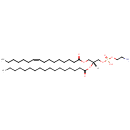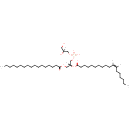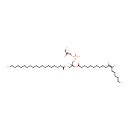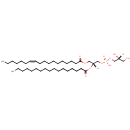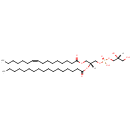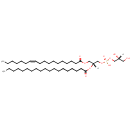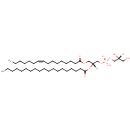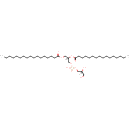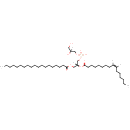
Search Results for compounds
Searching compounds for
returned 4373 results.
PE(16:1(9Z)/17:0) (PAMDB001481)
IUPAC:
(2-aminoethoxy)[(2R)-2-(heptadecanoyloxy)-3-[(9Z)-hexadec-9-enoyloxy]propoxy]phosphinic acid
CAS: Not Available
Description: PE(16:1(9Z)/17:0) is a phosphatidylethanolamine. It is a glycerophospholipid in which a phosphorylethanolamine moiety occupies a glycerol substitution site. As is the case with diacylglycerols, glycerophosphoethanolamines can have many different combinations of fatty acids of varying lengths and saturation attached to the C-1 and C-2 atoms. PE(16:1(9Z)/17:0), in particular, consists of one 9Z-hexadecenoyl chain to the C-1 atom, and one heptadecanoyl to the C-2 atom. While most phospholipids have a saturated fatty acid on C-1 and an unsaturated fatty acid on C-2 of the glycerol backbone, the fatty acid distribution at the C-1 and C-2 positions of glycerol within phospholipids is continually in flux, owing to phospholipid degradation and the continuous phospholipid remodeling that occurs while these molecules are in membranes. PEs are neutral zwitterions at physiological pH. They mostly have palmitic or stearic acid on carbon 1 and a long chain unsaturated fatty acid (e.g. 18:2, 20:4 and 22:6) on carbon 2. PE synthesis can occur via two pathways. The first requires that ethanolamine be activated by phosphorylation and then coupled to CDP. The ethanolamine is then transferred from CDP-ethanolamine to phosphatidic acid to yield PE. The second involves the decarboxylation of PS.
PE(16:1(9Z)/19:0) (PAMDB001482)
IUPAC:
(2-aminoethoxy)[(2R)-3-[(9Z)-hexadec-9-enoyloxy]-2-(nonadecanoyloxy)propoxy]phosphinic acid
CAS: Not Available
Description: PE(16:1(9Z)/19:0) is a phosphatidylethanolamine. It is a glycerophospholipid in which a phosphorylethanolamine moiety occupies a glycerol substitution site. As is the case with diacylglycerols, glycerophosphoethanolamines can have many different combinations of fatty acids of varying lengths and saturation attached to the C-1 and C-2 atoms. PE(16:1(9Z)/19:0), in particular, consists of one 9Z-hexadecenoyl chain to the C-1 atom, and one nonadecanoyl to the C-2 atom. While most phospholipids have a saturated fatty acid on C-1 and an unsaturated fatty acid on C-2 of the glycerol backbone, the fatty acid distribution at the C-1 and C-2 positions of glycerol within phospholipids is continually in flux, owing to phospholipid degradation and the continuous phospholipid remodeling that occurs while these molecules are in membranes. PEs are neutral zwitterions at physiological pH. They mostly have palmitic or stearic acid on carbon 1 and a long chain unsaturated fatty acid (e.g. 18:2, 20:4 and 22:6) on carbon 2. PE synthesis can occur via two pathways. The first requires that ethanolamine be activated by phosphorylation and then coupled to CDP. The ethanolamine is then transferred from CDP-ethanolamine to phosphatidic acid to yield PE. The second involves the decarboxylation of PS.
PG(18:1(11Z)/17:0) (PAMDB001483)
IUPAC:
[(2S)-2,3-dihydroxypropoxy][(2R)-3-(heptadecanoyloxy)-2-[(11Z)-octadec-11-enoyloxy]propoxy]phosphinic acid
CAS: Not Available
Description: PG(18:1(11Z)/17:0) is a phosphatidylglycerol. Phosphatidylglycerols consist of a glycerol 3-phosphate backbone esterified to either saturated or unsaturated fatty acids on carbons 1 and 2. As is the case with diacylglycerols, phosphatidylglycerols can have many different combinations of fatty acids of varying lengths and saturation attached to the C-1 and C-2 positions. PG(18:1(11Z)/17:0), in particular, consists of one 11Z-octadecenoyl chain to the C-1 atom, and one heptadecanoyl to the C-2 atom. In Pseudomonas aeruginosa glycerophospholipid metabolism, phosphatidylglycerol is formed from phosphatidic acid (1,2-diacyl-sn-glycerol 3-phosphate) by a sequence of enzymatic reactions that proceeds via two intermediates, cytidine diphosphate diacylglycerol (CDP-diacylglycerol) and phosphatidylglycerophosphate (PGP, a phosphorylated phosphatidylglycerol). Phosphatidylglycerols, along with CDP-diacylglycerol, also serve as precursor molecules for the synthesis of cardiolipin, a phospholipid found in membranes.
PG(18:1(11Z)/19:0) (PAMDB001484)
IUPAC:
[(2S)-2,3-dihydroxypropoxy][(2R)-3-(nonadecanoyloxy)-2-[(11Z)-octadec-11-enoyloxy]propoxy]phosphinic acid
CAS: Not Available
Description: PG(18:1(11Z)/19:0) is a phosphatidylglycerol. Phosphatidylglycerols consist of a glycerol 3-phosphate backbone esterified to either saturated or unsaturated fatty acids on carbons 1 and 2. As is the case with diacylglycerols, phosphatidylglycerols can have many different combinations of fatty acids of varying lengths and saturation attached to the C-1 and C-2 positions. PG(18:1(11Z)/19:0), in particular, consists of one 11Z-octadecenoyl chain to the C-1 atom, and one nonadecanoyl to the C-2 atom. In Pseudomonas aeruginosa glycerophospholipid metabolism, phosphatidylglycerol is formed from phosphatidic acid (1,2-diacyl-sn-glycerol 3-phosphate) by a sequence of enzymatic reactions that proceeds via two intermediates, cytidine diphosphate diacylglycerol (CDP-diacylglycerol) and phosphatidylglycerophosphate (PGP, a phosphorylated phosphatidylglycerol). Phosphatidylglycerols, along with CDP-diacylglycerol, also serve as precursor molecules for the synthesis of cardiolipin, a phospholipid found in membranes.
PG(17:0/18:1(11Z)) (PAMDB001485)
IUPAC:
[(2R)-2,3-dihydroxypropoxy][(2R)-2-(heptadecanoyloxy)-3-[(11Z)-octadec-11-enoyloxy]propoxy]phosphinic acid
CAS: Not Available
Description: PG(17:0/18:1(11Z)) is a phosphatidylglycerol. Phosphatidylglycerols consist of a glycerol 3-phosphate backbone esterified to either saturated or unsaturated fatty acids on carbons 1 and 2. As is the case with diacylglycerols, phosphatidylglycerols can have many different combinations of fatty acids of varying lengths and saturation attached to the C-1 and C-2 positions. PG(17:0/18:1(11Z)), in particular, consists of one heptadecanoyl chain to the C-1 atom, and one 11Z-octadecenoyl to the C-2 atom. In Pseudomonas aeruginosa glycerophospholipid metabolism, phosphatidylglycerol is formed from phosphatidic acid (1,2-diacyl-sn-glycerol 3-phosphate) by a sequence of enzymatic reactions that proceeds via two intermediates, cytidine diphosphate diacylglycerol (CDP-diacylglycerol) and phosphatidylglycerophosphate (PGP, a phosphorylated phosphatidylglycerol). Phosphatidylglycerols, along with CDP-diacylglycerol, also serve as precursor molecules for the synthesis of cardiolipin, a phospholipid found in membranes.
PG(17:0/16:1(9Z)) (PAMDB001486)
IUPAC:
[(2R)-2,3-dihydroxypropoxy][(2R)-2-(heptadecanoyloxy)-3-[(9Z)-hexadec-9-enoyloxy]propoxy]phosphinic acid
CAS: Not Available
Description: PG(17:0/16:1(9Z)) is a phosphatidylglycerol. Phosphatidylglycerols consist of a glycerol 3-phosphate backbone esterified to either saturated or unsaturated fatty acids on carbons 1 and 2. As is the case with diacylglycerols, phosphatidylglycerols can have many different combinations of fatty acids of varying lengths and saturation attached to the C-1 and C-2 positions. PG(17:0/16:1(9Z)), in particular, consists of one heptadecanoyl chain to the C-1 atom, and one 9Z-hexadecenoyl to the C-2 atom. In Pseudomonas aeruginosa glycerophospholipid metabolism, phosphatidylglycerol is formed from phosphatidic acid (1,2-diacyl-sn-glycerol 3-phosphate) by a sequence of enzymatic reactions that proceeds via two intermediates, cytidine diphosphate diacylglycerol (CDP-diacylglycerol) and phosphatidylglycerophosphate (PGP, a phosphorylated phosphatidylglycerol). Phosphatidylglycerols, along with CDP-diacylglycerol, also serve as precursor molecules for the synthesis of cardiolipin, a phospholipid found in membranes.
PG(19:0/18:1(11Z)) (PAMDB001487)
IUPAC:
[(2R)-2,3-dihydroxypropoxy][(2R)-2-(nonadecanoyloxy)-3-[(11Z)-octadec-11-enoyloxy]propoxy]phosphinic acid
CAS: Not Available
Description: PG(19:0/18:1(11Z)) is a phosphatidylglycerol. Phosphatidylglycerols consist of a glycerol 3-phosphate backbone esterified to either saturated or unsaturated fatty acids on carbons 1 and 2. As is the case with diacylglycerols, phosphatidylglycerols can have many different combinations of fatty acids of varying lengths and saturation attached to the C-1 and C-2 positions. PG(19:0/18:1(11Z)), in particular, consists of one nonadecanoyl chain to the C-1 atom, and one 11Z-octadecenoyl to the C-2 atom. In Pseudomonas aeruginosa glycerophospholipid metabolism, phosphatidylglycerol is formed from phosphatidic acid (1,2-diacyl-sn-glycerol 3-phosphate) by a sequence of enzymatic reactions that proceeds via two intermediates, cytidine diphosphate diacylglycerol (CDP-diacylglycerol) and phosphatidylglycerophosphate (PGP, a phosphorylated phosphatidylglycerol). Phosphatidylglycerols, along with CDP-diacylglycerol, also serve as precursor molecules for the synthesis of cardiolipin, a phospholipid found in membranes.
PG(19:0/16:1(9Z)) (PAMDB001488)
IUPAC:
[(2R)-2,3-dihydroxypropoxy][(2R)-3-[(9Z)-hexadec-9-enoyloxy]-2-(nonadecanoyloxy)propoxy]phosphinic acid
CAS: Not Available
Description: PG(19:0/16:1(9Z)) is a phosphatidylglycerol. Phosphatidylglycerols consist of a glycerol 3-phosphate backbone esterified to either saturated or unsaturated fatty acids on carbons 1 and 2. As is the case with diacylglycerols, phosphatidylglycerols can have many different combinations of fatty acids of varying lengths and saturation attached to the C-1 and C-2 positions. PG(19:0/16:1(9Z)), in particular, consists of one nonadecanoyl chain to the C-1 atom, and one 9Z-hexadecenoyl to the C-2 atom. In Pseudomonas aeruginosa glycerophospholipid metabolism, phosphatidylglycerol is formed from phosphatidic acid (1,2-diacyl-sn-glycerol 3-phosphate) by a sequence of enzymatic reactions that proceeds via two intermediates, cytidine diphosphate diacylglycerol (CDP-diacylglycerol) and phosphatidylglycerophosphate (PGP, a phosphorylated phosphatidylglycerol). Phosphatidylglycerols, along with CDP-diacylglycerol, also serve as precursor molecules for the synthesis of cardiolipin, a phospholipid found in membranes.
PG(16:0/17:0) (PAMDB001490)
IUPAC:
[(2S)-2,3-dihydroxypropoxy][(2R)-3-(heptadecanoyloxy)-2-(hexadecanoyloxy)propoxy]phosphinic acid
CAS: Not Available
Description: PG(16:0/17:0) is a phosphatidylglycerol. Phosphatidylglycerols consist of a glycerol 3-phosphate backbone esterified to either saturated or unsaturated fatty acids on carbons 1 and 2. As is the case with diacylglycerols, phosphatidylglycerols can have many different combinations of fatty acids of varying lengths and saturation attached to the C-1 and C-2 positions. PG(16:0/17:0), in particular, consists of one hexadecanoyl chain to the C-1 atom, and one heptadecanoyl to the C-2 atom. In Pseudomonas aeruginosa glycerophospholipid metabolism, phosphatidylglycerol is formed from phosphatidic acid (1,2-diacyl-sn-glycerol 3-phosphate) by a sequence of enzymatic reactions that proceeds via two intermediates, cytidine diphosphate diacylglycerol (CDP-diacylglycerol) and phosphatidylglycerophosphate (PGP, a phosphorylated phosphatidylglycerol). Phosphatidylglycerols, along with CDP-diacylglycerol, also serve as precursor molecules for the synthesis of cardiolipin, a phospholipid found in membranes.
PG(16:1(9Z)/19:0) (PAMDB001491)
IUPAC:
[(2S)-2,3-dihydroxypropoxy][(2R)-2-[(9Z)-hexadec-9-enoyloxy]-3-(nonadecanoyloxy)propoxy]phosphinic acid
CAS: Not Available
Description: PG(16:1(9Z)/19:0) is a phosphatidylglycerol. Phosphatidylglycerols consist of a glycerol 3-phosphate backbone esterified to either saturated or unsaturated fatty acids on carbons 1 and 2. As is the case with diacylglycerols, phosphatidylglycerols can have many different combinations of fatty acids of varying lengths and saturation attached to the C-1 and C-2 positions. PG(16:1(9Z)/19:0), in particular, consists of one 9Z-hexadecenoyl chain to the C-1 atom, and one nonadecanoyl to the C-2 atom. In Pseudomonas aeruginosa glycerophospholipid metabolism, phosphatidylglycerol is formed from phosphatidic acid (1,2-diacyl-sn-glycerol 3-phosphate) by a sequence of enzymatic reactions that proceeds via two intermediates, cytidine diphosphate diacylglycerol (CDP-diacylglycerol) and phosphatidylglycerophosphate (PGP, a phosphorylated phosphatidylglycerol). Phosphatidylglycerols, along with CDP-diacylglycerol, also serve as precursor molecules for the synthesis of cardiolipin, a phospholipid found in membranes.
